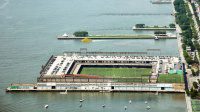Hudson River Park Trust Selects CH2M to Design Repairs for Pier 40 Support Piles

Hudson River Park Trust (HRPT) today announced the selection of CH2M as its Engineer of Record to oversee the design of vital repairs of the approximately 3,500 steel piles that hold up Pier 40.
One of the most important commercial properties in Hudson River Park, Pier 40 plays an integral role in supporting the Park’s annual operating budget. Originally designed as a passenger ship terminal, today Pier 40 is home to a commercial parking garage, athletic fields and the administrative offices of the Hudson River Park Trust. Its ballfields are a community asset that hosts tens of thousands of individuals of all ages each year. With a footprint of 15 acres, it is the largest pier structure on the Hudson River.
A 2014 report conducted by CH2M’s ports experts revealed that 57 percent of Pier 40’s steel piles are suffering major to severe deterioration, a worsening of 17 percent from the prior inspection conducted in 2009. Without critically needed repairs, the community would face the permanent loss of treasured community ballfields, along with significant income to support the park’s operations and a forced relocation of HRPT’s offices and park operations hub.
Last October, HRPT announced its intention to transfer development rights to the St. John’s Terminal site, subject to the approval of the City and then the Trust’s Board of Directors. In exchange, HRPT would receive an estimated $100 million from the St. John’s developer to repair the Pier 40 piles. If the project is ultimately approved by the City, repairs (estimated at $104.5 million in the 2014 report) will commence in 2017.
The pier is an 810-foot by 810-foot steel pile-supported high-level platform, which includes a 175-foot-wide, two-story shed and a 20-foot-wide apron that serves as a public esplanade along the perimeter. A 400-foot-long by 410-foot-wide courtyard and a 55-foot-wide by 142-foot long finger pier extension supporting a one-story shed are also part of the pier footprint.
CH2M will design the improvements needed to return Pier 40 to a state of good repair. The company’s local marine rehabilitation team will ensure all work is aligned to environmental and historical preservation requirements, with a goal of achieving a design life of 50+ years for the pier. HRPT expects the design process for the first phase to take approximately six months.
“Pier 40 is beloved by the community and an important resource for the Trust, so we’re pleased to select one of the world’s leading pier repair experts to ensure that the structure is engineered properly,” said HRPT President & CEO Madelyn Wils. “CH2M’s work will allow the pier to be repaired and open to the community for years to come.”
“CH2M looks forward to working with Hudson River Park Trust to complete the urgently needed repairs of Pier 40’s support piles, as our 2014 analysis indicated,” commented CH2M’s Principal-in-Charge Jonathan Goldstick, PE. “As a proud provider of professional engineering services to the Trust for the last 18 years, we are committed to rehabilitating Pier 40 for its continued use by the community.”
CH2M is pleased to deliver the project with Insight Civil Engineering, a woman-owned business enterprise, and KS Engineers, a minority-owned business enterprise. Both firms bring excellent technical capability and will provide professional services throughout the project duration.
HRPT selected CH2M through a Request for Proposal (RFP) issued on March 7 in anticipation of the ongoing re-zoning process conducted by New York City for the proposed redevelopment of the St. John’s Terminal, which is located across the West Side Highway from the pier. The developer of the St. John’s Terminal has released funds to the Trust so that the engineering of the repairs can begin.
HRPT is governed by the Hudson River Park Act and operates on a premise of financial self-sufficiency. Receiving no public funding for its operations, HRPT heavily relies on the few piers designated for limited commercial uses in the Hudson River Park Act, including Pier 40.
Pier 40 currently generates roughly one third of HRPT’s operating revenue, largely through its parking facility, which has declined in recent years due to closures from the pier’s condition. Over the past four years, the vast majority of Pier 40’s parking revenue has been redirected to urgently needed infrastructure repairs.
Should the St. John’s project successfully complete its public review process and the air rights transfer be approved by HRPT’s Board of Directors, HRPT will issue an RFP for a contractor to undertake pile repairs in the fall of 2016, with an expected work start date of spring 2017.


